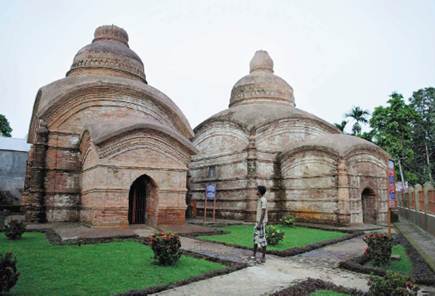Tripura’s forested hills hide many such secrets, such as the
rock murals of Devtamura. These panels lie in an extension of the Baramura
range in south-central Tripura. The river Gomati cuts an impressive gorge
through it, on its way past the old capital of Udaipur and beyond to the Meghna
river in Bangladesh. We got there a couple of days later from our base in
Udaipur. Villagers in Amarpur, the closest town, pointed us to a rough track
heading into the forest and our much-abused Alto bounced off to a Jamatiya
tribal village. This fiercely proud Tripuri tribe like most of their brethren,
are nominally Hindus. But the religion they follow is deeply animistic, one
shared by the other Kok Borok speaking tribes of the state. The supreme deity
is the male Matai Katar, who with his equally powerful consort Matai Katarma
controls the well-being of the people.

Tripura’s forested
hills
When we reached the Jamatiya village deep in the hills it
was past noon, and the stifling, still heat of the forest seemed like some
malevolent entity intent on sucking the life out of us. After much pleading the
villagers were understandably more interested in a siesta than sailing two
Jamatiya brothers agreed to take us down the river in their fishing canoe so we
could admire the panels. The first panel is actually a massive one, on a sheer
rock wall that rises up straight from the river into the surrounding forest,
sometimes called the Panchdevata panel. Another panel featuring thirty-seven
deities had long succumbed to the combined forces of sun and rain, but somehow
that made them more appropriate to the setting suggestive, autochthonous
deities presiding over their kingdom of deep forest and snaking river.

the giant tree
ferns
Sailing on the brown, sluggish Gomati thick with silt was
hard going, considering Puneet and I were overdressed for the occasion. The
brothers’ uniform of bare torso and lungi was far more appropriate. But the
magnificent forest soon held us in thrall. In the humid hush of the noonday
sun, the giant tree ferns, extensive climbers, orchids and bamboo thickets
glistened, giving the impression of living entities brooding by the water’s
edge. The silence, broken by the crashing of some unseen animal in the bamboo
thickets or the cry of a kingfisher, was all pervasive. The younger brother
rowed, pushing the canoe along with the help of a long bamboo pole. The depth
of this sluggish river was only five to six feet, as evidenced by two groups of
boatmen we passed on the way, treading the muddy bed of the river to catch
fish.

The beautiful
group of three temples called the gunabati guchcha in udaipur were built by the
king govinda manikya for his wife gunabati in 1668
An hour’s boat-ride brought us to the pièce de résistance of
this mysterious land a large rock-cut goddess figure poised with a trident much
like Durga, but with a flowing mane like Medusa. Its sudden appearance from the
thick canopy of the forest took my breath away. I’ve never been much impressed
with Sanskritised names, so when the elder brother told me in hushed tones that
they call her Sakragma, or the ghost woman, it seemed more apt somehow. Again,
the exact provenance of these sculptures is unknown, but the local legend goes
that one of the Manikya kings of Tripura, Amar Manikya, was engaged in warfare
with a king of Myanmar, when his army took shelter in these forests. Following
his victory, he ordered the carving of these sculptures. Through a comparative
study of coins and other artefacts, these can be dated to the fifteenth
century. Although created by royal decree, the sculptures are certainly tribal
in form. In fact, art historians have been able to find traces of the traditional
dress worn by Reang women in the Sakragma figure.